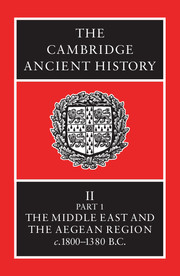Book contents
- Frontmatter
- Contents
- List of Maps
- List of Tables
- List of Text-figures
- Preface
- CHAPTER I NORTHERN MESOPOTAMIA AND SYRIA
- CHAPTER II EGYPT: FROM THE DEATH OF AMMENEMES III TO SEQENENRE II
- CHAPTER III PALESTINE IN THE MIDDLE BRONZE AGE
- CHAPTER IV
- CHAPTER V HAMMURABI AND THE END OF HIS DYNASTY
- CHAPTER VI ANATOLIA c. 1750–1600 B.C.
- CHAPTER VII PERSIA c. 1800–1550 B.C.
- CHAPTER VIII EGYPT: FROM THE EXPULSION OF THE HYKSOS TO AMENOPHIS I
- CHAPTER IX EGYPT: INTERNAL AFFAIRS FROM TUTHMOSIS I TO THE DEATH OF AMENOPHIS III
- CHAPTER X SYRIA c. 1550–1400 B.C.
- CHAPTER XI PALESTINE IN THE TIME OF THE EIGHTEENTH DYNASTY
- CHAPTER XII THE ZENITH OF MINOAN CIVILIZATION
- CHAPTER XIII THE LINEAR SCRIPTS AND THE TABLETS AS HISTORICAL DOCUMENTS
- CHAPTER XIV THE RISE OF MYCENAEAN CIVILIZATION
- CHAPTER XV ANATOLIA c. 1600–1380 b.c.
- CHAPTER XVI THE ARCHAEOLOGICAL EVIDENCE OF THE SECOND MILLENNIUM B.C. ON THE PERSIAN PLATEAU
- BIBLIOGRAPHIES
- Chronological Tables
- Index to Maps
- General Index
- Map 1: Greece and the Aegean Islands in the Middle Bronze Age.
- Map 3: Babylonia and Western Persia.
- Fig. 7. Plan of the Palace at Cnossus.
- Map 6: Ancient Asia Minor and Northern mesopotamia
- References
CHAPTER VII - PERSIA c. 1800–1550 B.C.
Published online by Cambridge University Press: 28 March 2008
- Frontmatter
- Contents
- List of Maps
- List of Tables
- List of Text-figures
- Preface
- CHAPTER I NORTHERN MESOPOTAMIA AND SYRIA
- CHAPTER II EGYPT: FROM THE DEATH OF AMMENEMES III TO SEQENENRE II
- CHAPTER III PALESTINE IN THE MIDDLE BRONZE AGE
- CHAPTER IV
- CHAPTER V HAMMURABI AND THE END OF HIS DYNASTY
- CHAPTER VI ANATOLIA c. 1750–1600 B.C.
- CHAPTER VII PERSIA c. 1800–1550 B.C.
- CHAPTER VIII EGYPT: FROM THE EXPULSION OF THE HYKSOS TO AMENOPHIS I
- CHAPTER IX EGYPT: INTERNAL AFFAIRS FROM TUTHMOSIS I TO THE DEATH OF AMENOPHIS III
- CHAPTER X SYRIA c. 1550–1400 B.C.
- CHAPTER XI PALESTINE IN THE TIME OF THE EIGHTEENTH DYNASTY
- CHAPTER XII THE ZENITH OF MINOAN CIVILIZATION
- CHAPTER XIII THE LINEAR SCRIPTS AND THE TABLETS AS HISTORICAL DOCUMENTS
- CHAPTER XIV THE RISE OF MYCENAEAN CIVILIZATION
- CHAPTER XV ANATOLIA c. 1600–1380 b.c.
- CHAPTER XVI THE ARCHAEOLOGICAL EVIDENCE OF THE SECOND MILLENNIUM B.C. ON THE PERSIAN PLATEAU
- BIBLIOGRAPHIES
- Chronological Tables
- Index to Maps
- General Index
- Map 1: Greece and the Aegean Islands in the Middle Bronze Age.
- Map 3: Babylonia and Western Persia.
- Fig. 7. Plan of the Palace at Cnossus.
- Map 6: Ancient Asia Minor and Northern mesopotamia
- References
Summary
THE DYNASTY OF THE ‘GRAND REGENT’ RULERS IN ELAM
To posterity the history of Persia at the time when the First Dynasty of Babylon held sway in Mesopotamia seems to narrow itself down to the history of Elam, and indeed almost down to the history of Susiana, the Elamite plain which bordered on Mesopotamia. Whatever took place in the mountainous parts of the country at this time remains shrouded in impenetrable obscurity. From the whole of Persia not a single archaeological monument has come down to us for this period, not even from Susiana. From only one Elamite ruler during the Early Babylonian period has a record in the Elamite language survived. Apart from this our sources from the country itself (leaving aside certain indications in Elamite inscriptions of the later, ‘classical’ period of the thirteenth to the twelfth centuries) consist of 837 clay tablets, written in Akkadian and in many cases damaged. Of these, somewhat more than half are legal documents, the remainder commercial texts; nearly all come from Susa, only a few from Mālamīr (possibly the ancient Khukhnur).
In view of this state of affairs with regard to the sources, the main task of the next section in this chapter must be to trace a picture of the legal system in ancient Elam. However, the records in question also provide important information about its political history, in so far as the Elamites often took oath by invoking the reigning princes.
- Type
- Chapter
- Information
- The Cambridge Ancient History , pp. 256 - 288Publisher: Cambridge University PressPrint publication year: 1973
References
- 1
- Cited by



